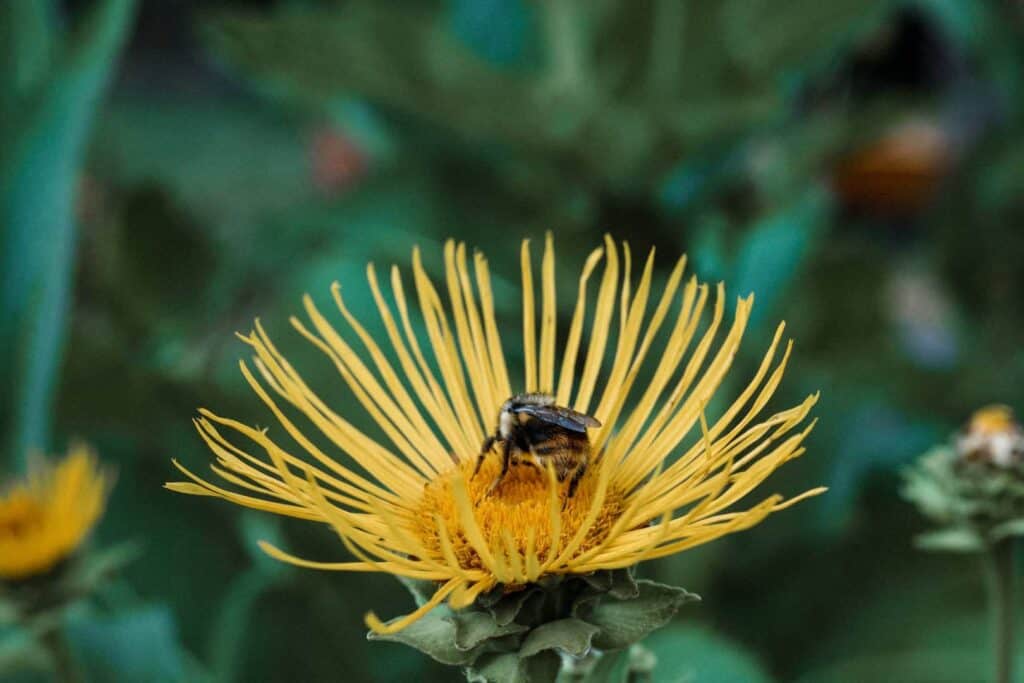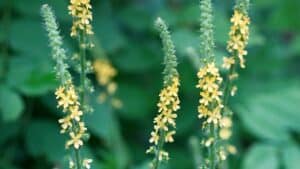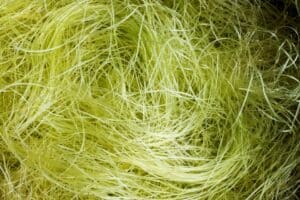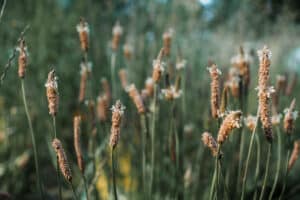Elecampane has become one of my personal favorite respiratory remedies over the years, not just for its medicinal benefits for many of the common respiratory woes people face today, but as a choice restorative agent. Whether you make it into a tincture or enjoy the syrup, Elecampane is a remedy every herbalist should know.
In today’s blog post, you’ll learn:
- Elecampane’s pungent and aromatic taste and how it corresponds to its core respiratory properties
- Why this herb is a primo respiratory remedy
- The connection between Elecampane and homesickness
- Elecampane’s correspondence to the Sun and Air Element
- How to prepare medicinal remedies with Elecampane
Table of Contents
Elecampane (Inula helenium)
Elecampane grows radiant and tall in the garden, flaunting bright yellow flowers and a deeply aromatic root. This is one of the best herbs you can use for a damp and cold respiratory condition or cough. With the winter upon us and the cold creeping up, Elecampane provides an innate warmth to the body and mind, revitalizing it from the inside out like the sun.
Taste
Elecampane is a pungent plant with a hot, spicy, and aromatic taste. The roots are rich in volatile essential oils and give Elecampane its distinct flavor. This herb also has some bitterness and acridity present. However, its pungency tends to override the other flavors because of its potency. While the bitter taste indicates a draining and drying effect, the acridity reveals antispasmodic and relaxant properties- all of which are exemplified in this herb’s herbal actions and organ affinities.
Affinities
Elecampane is a primo respiratory remedy, and I consider this its core organ affinity. This herb is unique in that it alleviates acute respiratory conditions and at the same time restores the innate functionality and health of the lungs when they have become worn down and weakened after chronic, prolonged, or frequent respiratory conditions.
The other main affinity I correspond with Elecampane is the digestive system. Elecampane supports digestive health with its aromatic and stimulant volatile oils and resins. These drive circulation to the GI, dispel gas, and help your body break down food and prepare it for elimination. The warming and drying effects of Elecampane are particularly helpful for damp, mucoid, and stagnant digestive conditions characterized by slow digestion and a chronic feeling of heaviness in the belly after eating.
Lastly, it will impact the cardiovascular system and circulation through its pungency, which drives the blood and warms the body. Although this isn’t a cardiovascular remedy per se, there’s no doubt that it positively impacts circulation with its stimulating properties.
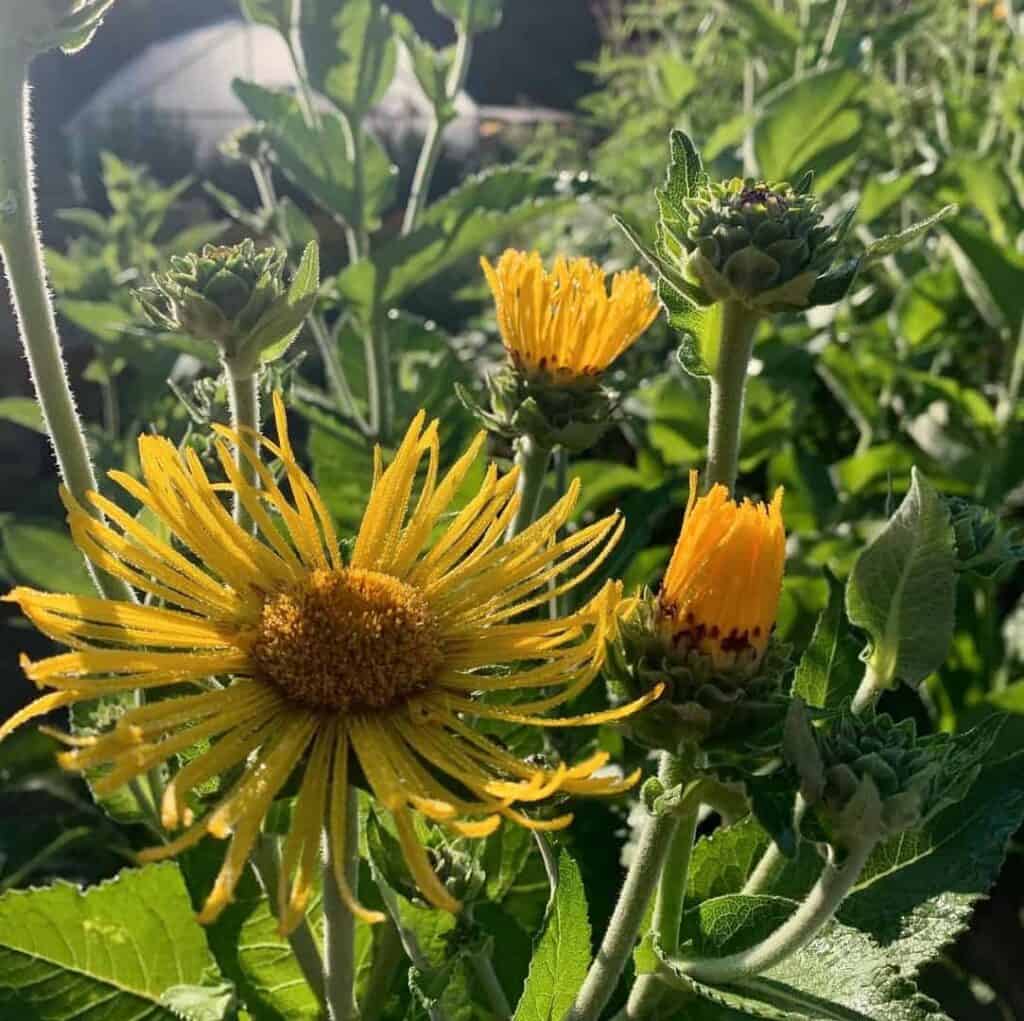
Actions
The main herbal action that comes to mind when I think of Elecampane is its stimulant expectorant property. As the name suggests, expectorants expel mucus from the lungs. However, not all expectorants are created equal. If you opened an herbalism book and looked up ‘expectorant,’ you may find numerous herbs listed, such as Marshmallow (Althaea officinalis), Mullein (Verbascum thapsus), and Elecampane. However, there are many kinds of expectorants, each indicated for respiratory conditions with different underlying energetics.
Elecampane irritates the respiratory mucosa through its volatile oils and resins, resulting in a pungent, warming, and stimulating expectorant. By stimulating these tissues, it encourages a productive cough. Use Elecampane when there is a cold, damp, phlegmatic cough with mucus that is difficult to expel. We might refer to that as an “unproductive cough.” Another specific indication is when your cough won’t go deep enough to get all the stagnant mucus out from your lungs. This can lead to excessive coughing with little to no relief. Elecampane breaks up the mucus with its aromatic compounds and stimulates the tissues to a deeper cough to clear the lungs.
Because Elecampane is so stimulating and warming, you can see it having a stimulant diaphoretic effect. This herb works well to break a fever, especially when there is a cough present and the person is cold and shivering. Elecampane brings the blood to the surface of the skin, opens the capillary beds, and warms the person so they can produce sweat and break the fever.
Elecampane is a respiratory trophorestorative, an uncommon herbal action in the Western Materia Medica. This action refers to the ability to restore functionality and health to an organ or organ system. In the case of Elecampane, it helps to clear chronic pectoral states, re-establishes proper mucosal secretions, and strengthens the lungs. These effects make Elecampane a powerful remedy to consider when there are long-standing respiratory conditions, a lingering cough after infection, or dyspnea.
Matthew Wood speaks about Elecampane as being great for people who develop asthma as a result of long-standing respiratory conditions. The acridity of this herb relaxes muscle spasms and tension, helping you take deeper and fuller breaths.
Elecampane affects the immune system with its antiseptic resins and volatile oils. It is great for bacterial infections, especially when the mucus is yellow to green. It is said that if you take Elecampane, the mucus will start to thin and become clear in color- all signs that the infection is clearing.
Because Elecampane is so effective at expectorating mucus and absolves the cause at its root, it is indicated for mucoid digestion that leads to nausea. When you have a lot of mucus in the lungs, this can make its way into the stomach and lead to indigestion and nausea. Alternatively, excess phlegm in the stomach can make its way into the lungs. In either case, there is a pattern of excess kapha, or dampness, which Elecampane drains away with its mild bitter tonic action. Coupled with its antiseptic properties, Elecampane is good for clearing out infection and moving the lymph when there is stagnation in the gut.
Lastly, Elecampane is a prebiotic plant. Prebiotics are plants that contain fiber that acts as food for the beneficial bacteria in your gut. It stimulates the repopulation of your gut with healthy and beneficial bacteria and can be used to strengthen and heal the digestive system. Inulin is the specific prebiotic polysaccharide present in Elecampane, which derived its name from the latin genus of Elecampane, Inula. Other herbs that contain high amounts of inulin include Dandelion root (Taraxacum officinale) and Burdock (Arctium lappa).
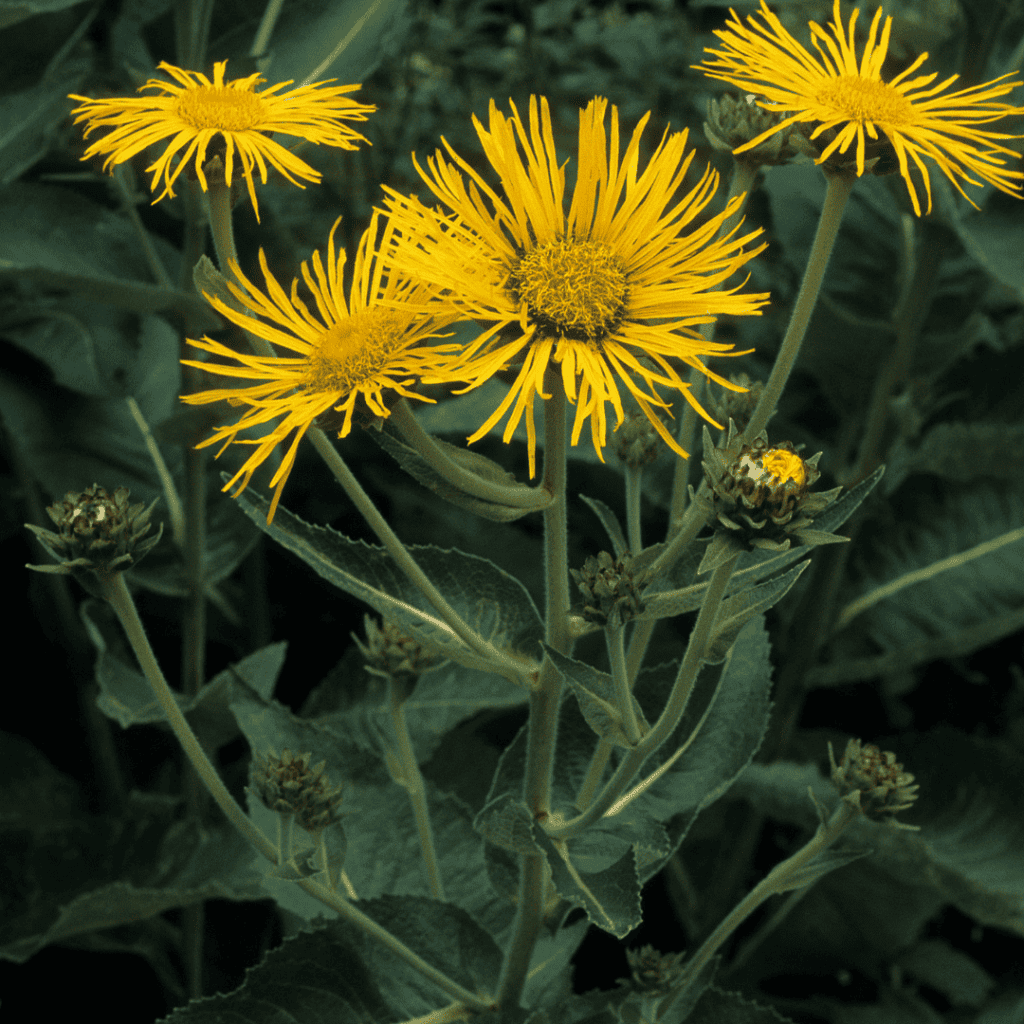
Energetics
Elecampane is distinctly pungent and warming. In the Greek tradition, Elecampane is warming in the 3rd degree, which means it thins fluids and pushes heat to the surface to produce a sweat. You can see this illustrated with its stimulant diaphoretic quality, circulatory property, and warming effects on the lungs and stomach.
Although this herb slightly increases mucilage in the lungs, Elecampane is considered a net-drying plant. This is because when you sweat and cough up mucus, you’re losing fluids. Elecampane is also drying due to its warming volatile oils and resins. Elecampane has a mild relaxant effect on tissue tone. You can trace this back to its acrid taste, which relaxes muscle tension and spasm. Lastly, Elecampane is stimulating, which you see through its stimulant diaphoretic, expectorant, and circulatory effects.
In terms of Elecampane’s influence on the Ayurvedic doshas, it is a specific remedy for reducing excess kapha dosha. Elecampane balances the coldness, dampness, and heaviness of kapha with its warming, drying, and stimulating properties.
Because of its pungency, warmth, and oiliness, Elecampane aggravates pitta. This herb can be beneficial to vata, especially because of its circulatory warming and relaxant effects. However, it can also exacerbate the dryness of vata and may work best when combined with moistening plants.
According to the Physiomedicalists, Elecampane is indicated for cold/depression and damp/stagnation tissue states. With its stimulant, pungent, and warming properties, Elecampanes restores vitality and functioning to the organs when there is a pattern of cold/depression. Its drying and expectorant qualities make it an excellent remedy for damp/stagnation conditions characterized by excess mucus and thickened fluids that become difficult to drain.
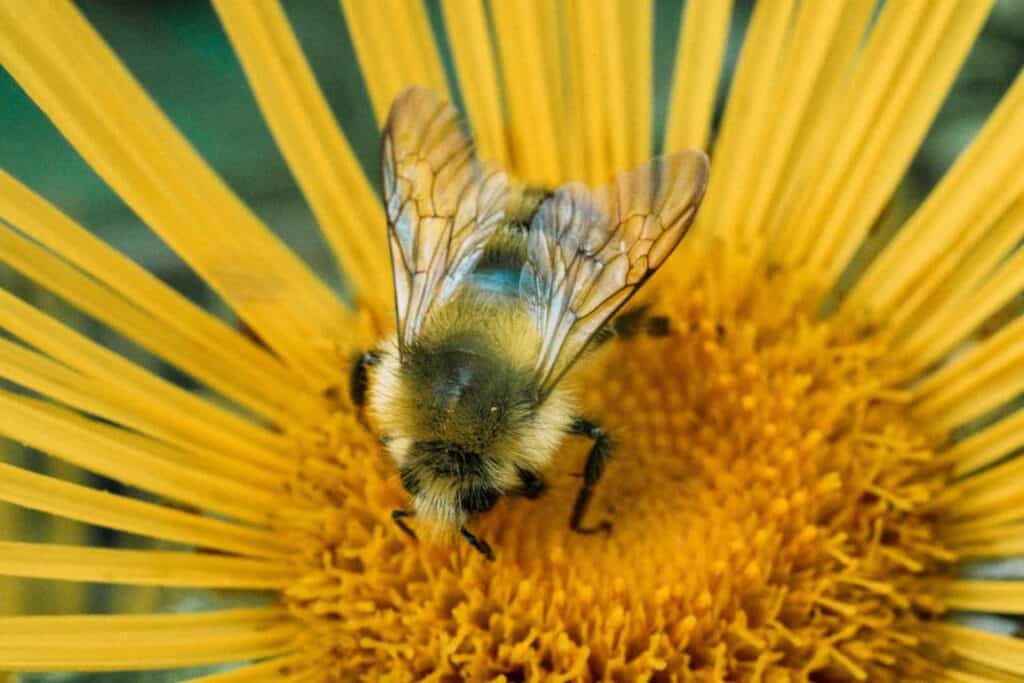
Psychological and emotional aspects
Similar to Elecampane’s warming and uplifting effect on the body, it brings these qualities to the mind. Elecampane is indicated for loneliness and grief, particularly when related to homesickness or a sense of loss of home. It has an uplifting effect on the depressive weight that can ensue and brightens the mind with its revitalizing and optimistic sun-like energy.
Alchemical Correspondences
I consider Elecampane to be governed by the Sun. With its bright yellow sun-looking flowers and pungent and aromatic root, Elecampane brings warmth and vitality to the entire body and mind. This herb drives the blood flow to the lungs, gut, skin surface, and increases the vitality and functionality of the organ systems. Within the mind, it uplifts depression associated with homesickness and loss of home, whether literal or metaphorical. In this way, it balances an excess of the Moon since the Moon rules the fourth house, which influences your relationship with family and home. Lastly, Elecampane’s stimulant, warming, and drying sun-like qualities counter the damp cold energetics associated with the Moon.
In medical astrology, the Sun represents your core vitality, often associated with warmth. While Elecampane doesn’t necessarily work like a chi tonic or rasayana or adaptogen, it does have a restorative quality to the digestion and the respiratory system, along with bringing in an overall radiant heat and energy to the system that supports in overall vitality.
Elementally speaking, Elecampane is associated with the Air Element. This is seen through its entire respiratory system affinity and its ability to uplift the heart in times of separation from home, or your ‘root.’
Alchemically I would correlate it to the Salt Principle, which relates to the Earth and Water Elements. We see this relationship in how it influences and restores and rejuvenates the body, notably the digestive system here. We also see this relationship in its overall stout and robust appearance, and that the root is the primary part of the plant used as medicine.
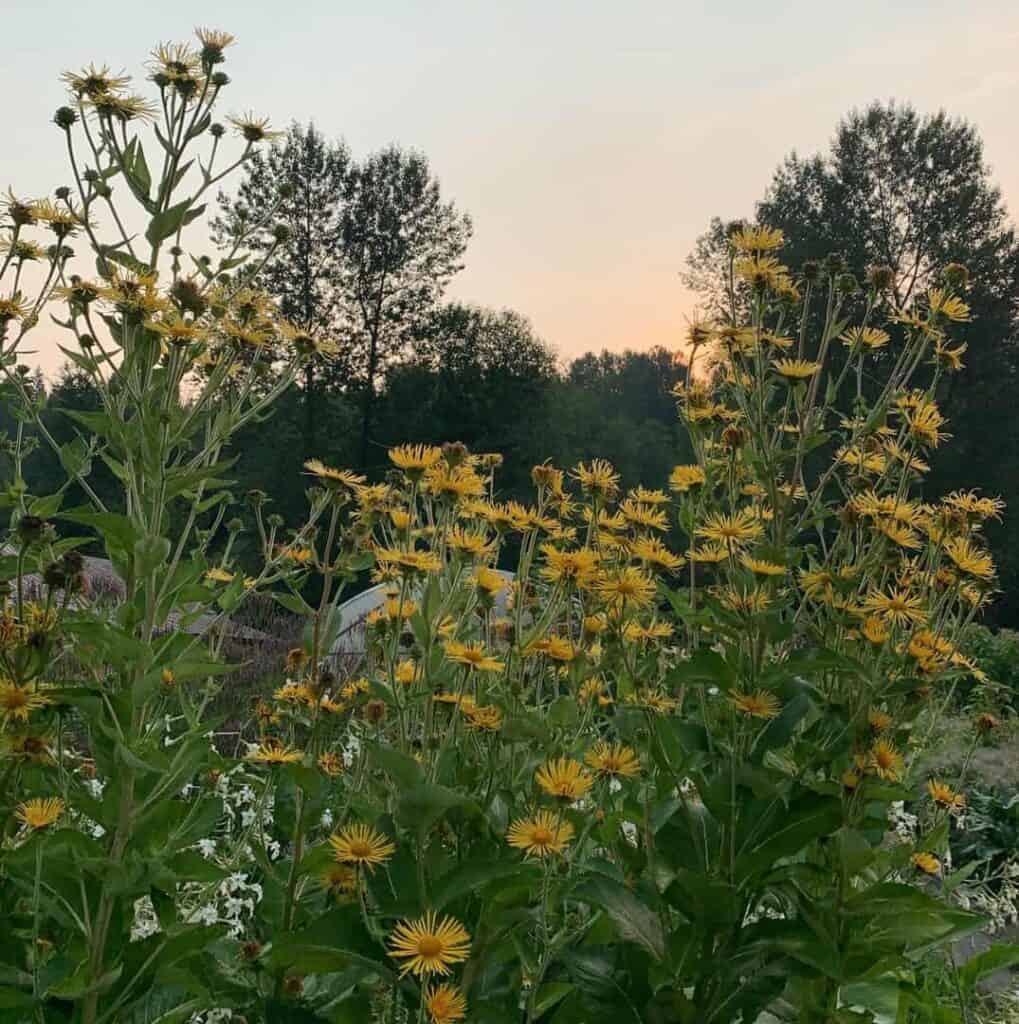
Growing
Elecampane has glorious yellow flowers with big broad leaves. This herb grows to be super tall and sometimes gets so heavy that it falls over (a good signature for plants high in the Earth/Water/Salt principles). If you’re looking for a plant with a presence, Elecampane will certainly bring it to your garden!
This herb is a perennial native to Europe and parts of Asia. It grows well in sunny conditions and well-drained soils, although it is rather forgiving if the conditions aren’t perfect. Elecampane is a light-dependent germinator, so place the seeds on top of your soil and sprinkle a fine layer of vermiculite on top so they’re still exposed to light and can grow.
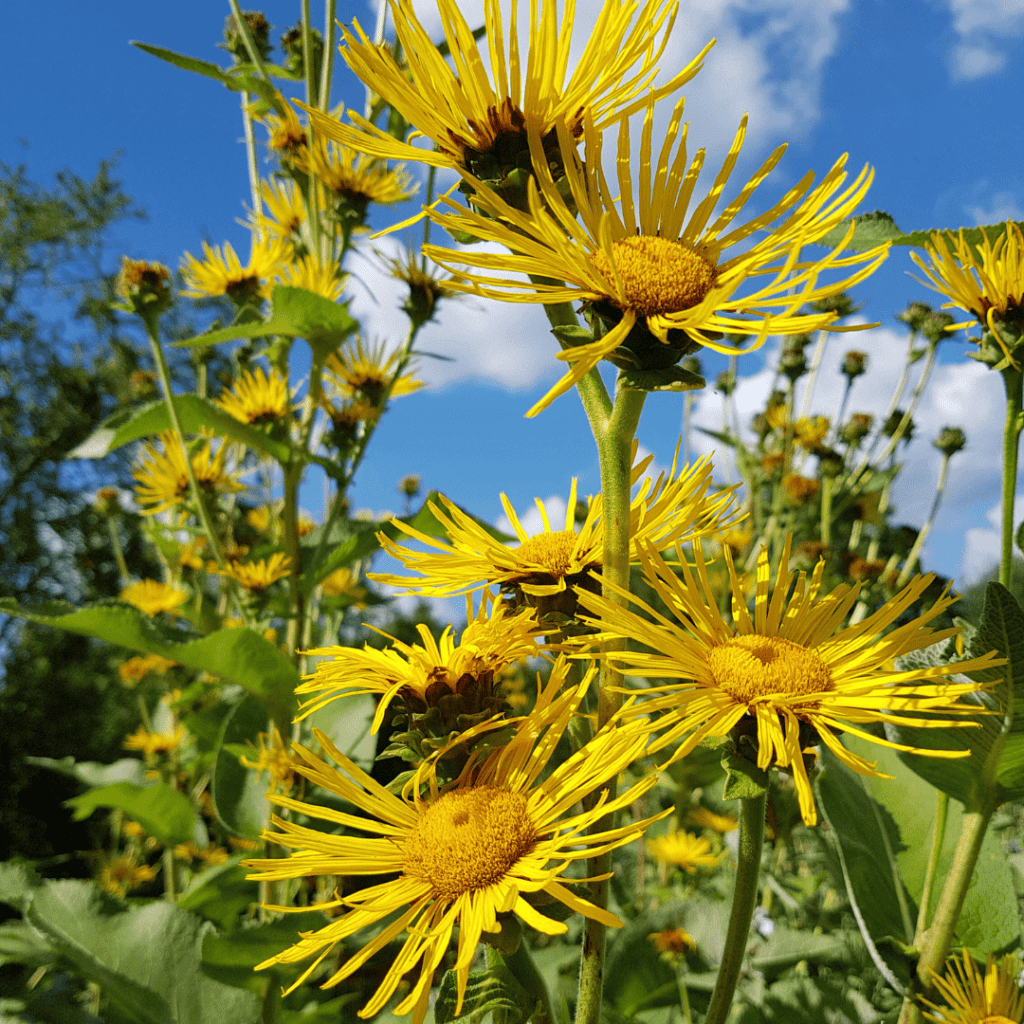
Preparation
The medicinal parts of Elecampane are the roots, which you want to leave to grow for a full two years before you dig them up and use them. This allows them to grow and develop to full maturity. The best time to harvest them is in the fall after the plant has become dormant. Alternatively, you can harvest them in early springtime before the plant starts to flower. During that time, you can divide the roots and propagate them further so the herb can flourish without becoming too compact in the soil.
After you harvest the roots, clean them well and use them fresh to make a tincture. Because the roots are so high in volatile oils and resins, they do well in a high percentage of alcohol when making a tincture. This can range between 80, 90, and 95% alcohol.
You can also make a cough syrup with Elecampane for a bronchial infection, and it pairs well with other aromatic warming herbs, such as Pleurisy root (Asclepias tuberosa) and Ginger (Zingiber officinale). A syrup is a strong decoction preserved with honey and brandy, though many just contain a sweetener and no alcohol. Lastly, you can cut the harvested and clean roots and dry them out to use later on for a decoction or other medicine making projects.
The aromatic, spicy, and warming flavor of Elecampane cuts through the frigid wintertime, and its revitalizing stimulating property wakes up the body and mind. With its affinity for the respiratory system and its deep trophorestorative and replenishing effects, I can’t think of a better plant to work with during winter than sun-like Elecampane.
Prebiotic Decoction
2 parts Dandelion root (Taraxacum officinale)
2 parts Burdock root (Arctium lappa)
1 part Elecampane root (Inula helenium)
½ part Marshmallow root (Althea officinalis)
This formula combines 3 prebiotic rich plants alongside moistening Marshmallow root to prevent it from being too drying. Add each herb to a pot, and for every 1 tablespoon of herb, add 1 cup of water. Cover and bring the combination to a gentle simmer for at least 45 minutes, or until the liquid has reduced by half and is strong in flavor and scent. Strain, pour, and enjoy.


